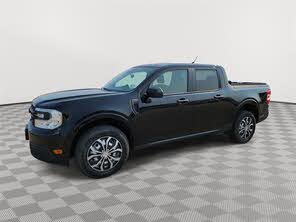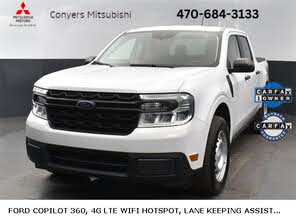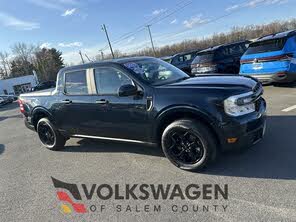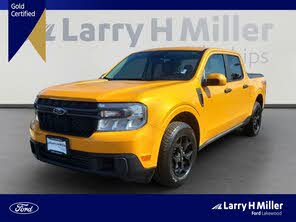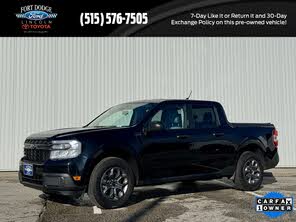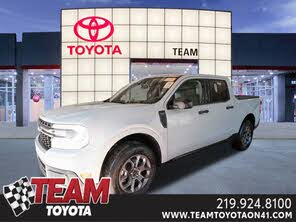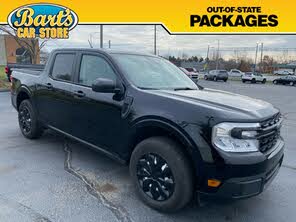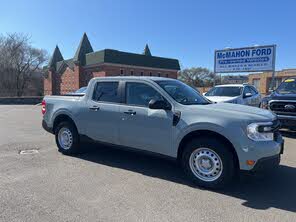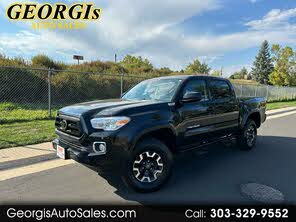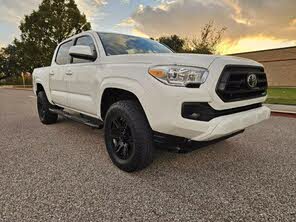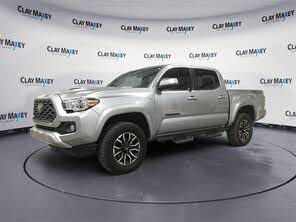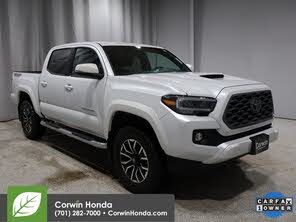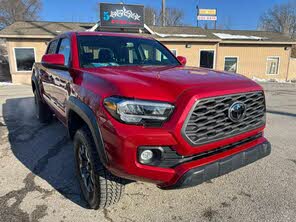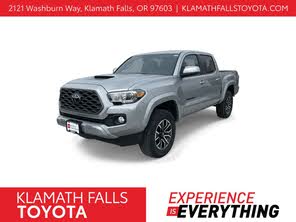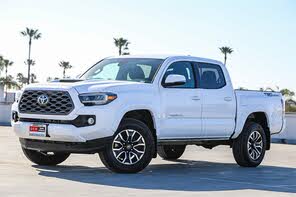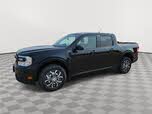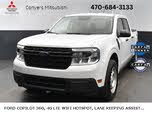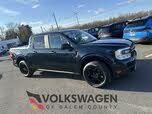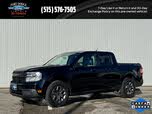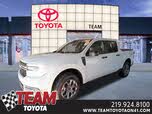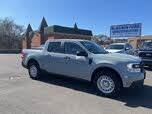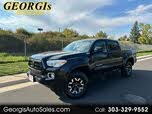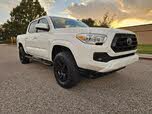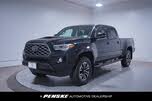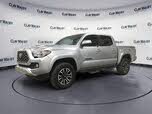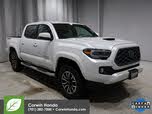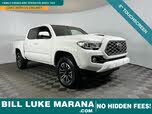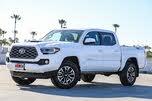2022 Ford Maverick vs 2022 Toyota Tacoma
Overview | |
MSRP$20,995 | MSRP$27,150 |
Average price$26,065 | Average price$34,643 |
Listings938 | Listings3146 |
Ratings & Reviews | |
User Reviews | User Reviews |
Expert reviews8.2 out of 10 | Expert reviews7.5 out of 10 |
Pros
| Pros
|
2022 Ford Maverick Reviews SummaryAmericans buy more Ford pickup trucks than they do any other vehicle, but that doesn’t mean the Blue Oval is satisfied. The 2022 Ford Maverick aims to further expand the market by offering a more approachable version of the pickup. The Maverick is the smallest Ford truck in over a decade, uses car-like unibody construction for greater refinement, and emphasizes fuel economy with an available hybrid powertrain. The Maverick’s closest rivals are the 2022 Hyundai Santa Cruz and the Honda Ridgeline, other unibody pickups of similar size. But while the new Santa Cruz was conceived more as an SUV with a bed, the Maverick is more like a conventional pickup, just smaller than Ford’s other offerings. The Maverick slots just below the Ford Ranger in size, although it’s still a bit larger than the compact pickups of old. With the demise of the EcoSport crossover, the Maverick is also now Ford’s de facto entry-level vehicle, which seems fitting for a company whose bestselling product is the F-150. Ford isn’t really a car company; it’s a truck company. While the Ford F-150 is available in a dizzying array of configurations, the automaker kept things simple with the 2022 Maverick. The new Ford pickup is available in just three trim levels—XL, XLT, and Lariat—with a single bed length and cab configuration. At Ford’s invitation, we sampled the full lineup over two days on the roads around Nashville, Tennessee. | |
2022 Toyota Tacoma Reviews SummaryOther small trucks have come and gone—and come back again—but the Toyota Tacoma has been the cornerstone of the segment for decades now. Though it has grown in size through the years, it has remained one of the best options if you’re in the market for a smaller alternative to full-size pickups. It’s a great option for a commuter who goes on the occasional camping, kayaking, or mountain biking adventure. The bed is good for picking up supplies to tackle a weekend project. But the midsize Tacoma has increased competition. In the past decade, the Chevrolet Colorado, GMC Canyon, and Ford Ranger have returned. The Nissan Frontier recently received a long-overdue overhaul. And there’s even a new crop of compact pickups, including the Hyundai Santa Cruz and Ford Maverick. So is the Tacoma still the big dog among small trucks? | |
Popular Features & Specs | |
Engine2.5L 191 hp I4 Hybrid | Engine2.7L 159 hp I4 |
Drive TrainFWD | Drive Train4X2 |
Seating Capacity5 | Seating Capacity4 |
Horsepower | Horsepower159 hp @ 5200 rpm |
MPG City42 | MPG City20 |
MPG Highway33 | MPG Highway23 |
Engine | |
Engine Name2.5L 191 hp I4 Hybrid | Engine Name2.7L 159 hp I4 |
Torque | Torque180 lb-ft @ 3800 rpm |
Horsepower | Horsepower159 hp @ 5200 rpm |
DrivetrainFWD | Drivetrain4X2 |
Fuel Economy | |
MPG City42 | MPG City20 |
MPG Highway33 | MPG Highway23 |
Interior | |
Seating Capacity5 | Seating Capacity4 |
Safety | |
Front Crash Overall5 | Front Crash Overall4 |
Side Crash Overall5 | Side Crash Overall5 |
Dimensions & Capacity | |
Bed Length54.4 in | Bed Length73.7 in |
Curb Weight3674 lbs | Curb Weight3915 lbs |
Height68.7 in | Height70.6 in |
Length199.7 in | Length212.3 in |
Width83.5 in | Width74.4 in |
Wheelbase121.1 in | Wheelbase127.4 in |
Maximum Payload1500 lbs | Maximum Payload1685 lbs |
Number of doors4 | Number of doors4 |
Maximum Towing Capacity2000 lbs | Maximum Towing Capacity3500 lbs |
Overview | ||
MSRP | $20,995 | $27,150 |
Average price | $26,065 | $34,643 |
Listings | ||
Ratings & Reviews | ||
User reviews | ||
Expert reviews | 8.2 out of 10Read full review | 7.5 out of 10Read full review |
Pros & cons | Pros
| Pros
|
Summary | Americans buy more Ford pickup trucks than they do any other vehicle, but that doesn’t mean the Blue Oval is satisfied. The 2022 Ford Maverick aims to further expand the market by offering a more approachable version of the pickup. The Maverick is the smallest Ford truck in over a decade, uses car-like unibody construction for greater refinement, and emphasizes fuel economy with an available hybrid powertrain. The Maverick’s closest rivals are the 2022 Hyundai Santa Cruz and the Honda Ridgeline, other unibody pickups of similar size. But while the new Santa Cruz was conceived more as an SUV with a bed, the Maverick is more like a conventional pickup, just smaller than Ford’s other offerings. The Maverick slots just below the Ford Ranger in size, although it’s still a bit larger than the compact pickups of old. With the demise of the EcoSport crossover, the Maverick is also now Ford’s de facto entry-level vehicle, which seems fitting for a company whose bestselling product is the F-150. Ford isn’t really a car company; it’s a truck company. While the Ford F-150 is available in a dizzying array of configurations, the automaker kept things simple with the 2022 Maverick. The new Ford pickup is available in just three trim levels—XL, XLT, and Lariat—with a single bed length and cab configuration. At Ford’s invitation, we sampled the full lineup over two days on the roads around Nashville, Tennessee. | Other small trucks have come and gone—and come back again—but the Toyota Tacoma has been the cornerstone of the segment for decades now. Though it has grown in size through the years, it has remained one of the best options if you’re in the market for a smaller alternative to full-size pickups. It’s a great option for a commuter who goes on the occasional camping, kayaking, or mountain biking adventure. The bed is good for picking up supplies to tackle a weekend project. But the midsize Tacoma has increased competition. In the past decade, the Chevrolet Colorado, GMC Canyon, and Ford Ranger have returned. The Nissan Frontier recently received a long-overdue overhaul. And there’s even a new crop of compact pickups, including the Hyundai Santa Cruz and Ford Maverick. So is the Tacoma still the big dog among small trucks? |
Video | ||
Popular Features & Specs | ||
Engine | 2.5L 191 hp I4 Hybrid | 2.7L 159 hp I4 |
Drive Train | FWD | 4X2 |
Seating Capacity | 5 | 4 |
Horsepower | 159 hp @ 5200 rpm | |
MPG City | 42 | 20 |
MPG Highway | 33 | 23 |
Engine | ||
Engine Name | 2.5L 191 hp I4 Hybrid | 2.7L 159 hp I4 |
Torque | 180 lb-ft @ 3800 rpm | |
Horsepower | 159 hp @ 5200 rpm | |
Drivetrain | FWD | 4X2 |
Fuel Economy | ||
MPG City | 42 | 20 |
MPG Highway | 33 | 23 |
Interior | ||
Seating Capacity | 5 | 4 |
Safety | ||
Front Crash Overall | 5 | 4 |
Side Crash Overall | 5 | 5 |
Dimensions & Capacity | ||
Bed Length | 54.4 in | 73.7 in |
Curb Weight | 3674 lbs | 3915 lbs |
Height | 68.7 in | 70.6 in |
Length | 199.7 in | 212.3 in |
Width | 83.5 in | 74.4 in |
Wheelbase | 121.1 in | 127.4 in |
Maximum Payload | 1500 lbs | 1685 lbs |
Number of doors | 4 | 4 |
Maximum Towing Capacity | 2000 lbs | 3500 lbs |
The 2022 Ford Maverick was designed to resemble a conventional pickup, standing in contrast to the more aerodynamic Hyundai Santa Cruz. Most of its design elements took cues from Ford's larger trucks, featuring prominent wheel arches and taillights reminiscent of the F-150 and Ranger models. However, its front-end design deviated from Ford's traditional truck look, with large headlights and a distinctive grille crossbar that didn't make a particularly bold styling statement.
Smaller than the midsize Ford Ranger, the Maverick was 199.7 inches long, almost a foot shorter than the Ranger, with a lower height of 68.7 inches. Unlike the traditional body-on-frame construction of Ford's larger trucks, the Maverick employed the C2 unibody platform shared with the Ford Escape and Bronco Sport crossover SUVs.
The Maverick XL, as the base model, was equipped with 17-inch steel wheels, while higher trims received 17-inch or 18-inch alloy wheels. The special Maverick First Edition package, exclusive to the 2022 model year and based on the Lariat trim, added features like black graphics, a soft tonneau cover, and unique wheels and paint options. Luxury packages available on the XLT and Lariat trims included amenities such as a leather-wrapped heated steering wheel and heated seats.
Inside, even the base Maverick did a commendable job of elevating budget materials into a stylish interior. Heavy on plastic, the cockpit featured multicolored panels with a speckled texture reminiscent of playground equipment. Exposed fasteners and minimally constructed door cards added a touch of character, while the base XL's woven-patterned seats presented an appealing aesthetic. Higher trims offered leather upholstery.
Ford's design team attempted to retain style without sacrificing affordability or utility. The Maverick’s interior managed to deliver an engaging and visually appealing design, proving that entry-level vehicles didn't have to lack in style, defining its "plastic fantastic" ethos.
Toyota’s Tacoma, despite being in the market since 1995 and remaining a staple due to its reliability, started to show signs of aging by 2022. The third-generation Tacoma, introduced in 2016, received a facelift in 2020, but its age was evident, especially in the cabin.
Externally, the Tacoma sported a contemporary look with an aggressive grille and headlights. However, stepping inside revealed its vintage, with hard plastics and older switchgear still in place. Although the design incorporated newer elements like a push-button start, these modern inclusions seemed squeezed into an otherwise dated layout.
The Tacoma was offered in multiple trims: SR, SR5, TRD Sport, TRD Off-Road, Limited, and the range-topping TRD Pro. The base SR trim featured 16-inch steel wheels, Class IV tow hitch, manually sliding rear window, air conditioning, manual seats, USB ports, and a 7-inch touchscreen with Apple CarPlay, Android Auto, and Amazon Alexa. Higher trims, such as the SR5, added fog lights, a leather-wrapped steering wheel, and upgraded infotainment to an 8-inch touchscreen. The TRD Sport brought in 17-inch alloy wheels, a sport-tuned suspension, dual-zone climate control, push-button start, and more.
The TRD Off-Road trim, while switching back to 16-inch wheels with all-terrain tires, included features tailored for trail use such as Bilstein shocks and a locking rear differential. The Limited trim was geared towards on-road comfort, featuring 18-inch polished wheels, leather upholstery, premium audio, navigation, heated seats, and a moonroof.
The TRD Pro model, with its optional leather, added unique exterior touches, underbody skid plates, LED fog lights, a TRD-tuned suspension, and sport exhaust. The Toyota Tacoma managed to blend utility with rugged styling, albeit with an interior showing its age against newer competitors.
The 2022 Ford Maverick offered a standout performance package starting with its standard hybrid powertrain, featuring a 2.5-liter Atkinson-cycle four-cylinder engine paired with a single electric motor and a continuously variable transmission (CVT). This combination produced a total system output of 191 horsepower and 155 pound-feet of torque. Alternatively, buyers could opt for a more powerful 2.0-liter EcoBoost turbocharged four-cylinder engine delivering 250 horsepower and 277 pound-feet of torque, mated to an eight-speed automatic transmission.
The Maverick hybrid came exclusively with front-wheel drive (FWD), while the EcoBoost variant provided FWD or optional all-wheel drive (AWD). An FX4 off-road package, available for AWD XLT and Lariat trims, enhanced off-road performance with modified suspension, extra underbody protection, hill-descent control, and specific drive modes (Mud/Rut and Sand). All-terrain tires were an additional option for FX4 models.
During test drives, the Maverick FX4 handled a challenging off-road course with ease, navigating rocky inclines and muddy paths. Though not suited for extreme off-roading, the FX4 showcased more off-road capability compared to most crossovers in its price range.
On paved roads, the Maverick’s unibody platform ensured a smoother ride compared to traditional body-on-frame pickups. The ride quality excelled, with less shudder over bumps commonly experienced in other trucks. Despite a tall hood affecting forward visibility, ample exterior mirrors and low door sills aided maneuvering in tight spots. As a small pickup, the Maverick proved easier to park than full-size trucks.
The hybrid variant was noted for its linear power delivery and refined driving experience, while the EcoBoost offered AWD, enhanced towing capabilities, and brisk acceleration.
The Toyota Tacoma’s base engine, a 2.7-liter four-cylinder, generated 159 horsepower and 180 pound-feet of torque. However, this engine was considered underpowered without any significant fuel economy benefits. The preferable upgrade was the 3.5-liter V6 engine, producing 278 horsepower and 265 pound-feet of torque, available as an option on the SR and SR5 trims and standard on higher trims. The Tacoma's maximum towing capacity was 6,800 pounds, with a payload capacity of 1,685 pounds when properly equipped.
Both engines channeled power to rear-wheel drive or optional four-wheel drive (4WD) via a six-speed automatic transmission. The TRD models also offered a six-speed manual transmission.
While the V6 presented better performance than the base four-cylinder, it still struggled with confident acceleration, particularly on highways due to its gearing and transmission. Around town, the V6 provided decent off-the-line acceleration and a full-size truck-like cruising experience. Despite being designed for the trail, the suspension struck a balance between smooth ride quality and stable cornering, although steering at low speeds felt laborious.
The TRD Pro trim excelled off-road, absorbing terrain irregularities effortlessly. Its steering, while sluggish in a parking lot, was finely tuned for trail navigation. Off-road features like Multi-Terrain Select and Crawl Control aided in controlling the vehicle on challenging trails, ensuring the Tacoma TRD models delivered in rough conditions.
The Maverick was exclusively available as a four-door crew cab, offering more legroom than the larger Toyota Tacoma and even surpassing the Hyundai Santa Cruz in front-seat legroom and rear-seat legroom in its 2.0-liter EcoBoost form. However, the Hyundai trumped the Maverick in headroom and shoulder room for both rows.
In terms of storage, the Maverick excelled with numerous compartments for small items, including cubbies around the touchscreen and in the center console. Additional storage under the rear seats, a large storage bin, cupholders, and an open door-card design with clips for large water bottles added to its practicality. The Ford Integrated Tether System (FITS) allowed for customizable storage solutions, and Ford provided specs for customers to 3D-print their own accessories.
The Maverick featured a 4.5-foot bed, half a foot shorter than the Ford Ranger’s crew-cab bed but still capable with a 1,500-pound payload capacity. In-bed features included a power outlet, tailgate tiedowns that doubled as bottle openers, and low bed sides for easier access. The FlexBed system maximized utility with tiedown cleats, indents for dividers or a false floor, and a multi-position tailgate for versatile cargo handling.
The Maverick's maximum towing capacity was 4,000 pounds (2,000 pounds for the hybrid), providing sufficient capability despite being lower than some crossover SUVs. It outperformed the Hyundai Santa Cruz in towing, although the Hyundai had a higher maximum payload capacity.
The Tacoma was available in Access Cab (extended cab) and Double Cab (crew cab) configurations, with bed lengths of five feet or six feet one inch. The Access Cab, with clamshell rear half-doors, seated four with tight rear jump seats better suited for children or internal storage. The Double Cab offered four full doors and seating for up to five, though rear legroom remained cramped for adults on longer trips.
In the front, the Tacoma provided ample legroom with seats that could slide far back. However, the tilt/telescoping steering wheel's limited extension forced taller drivers to compromise between legroom and arm reach. For those who found a comfortable position, the Tacoma's cab was equipped with numerous cupholders and storage solutions. The bed featured useful in-bed lighting and a wall-style power outlet.
In terms of cargo capacity, the Tacoma's maximum towing capacity was 6,800 pounds, with a payload capacity of 1,685 pounds, showcasing its strength in hauling heavier loads compared to the Maverick.
The Maverick, positioned as an entry-level vehicle, came with the older Sync 3 infotainment system, rather than the latest Sync 4. It featured standard Apple CarPlay and Android Auto, though not the wireless versions. An 8-inch touchscreen and a built-in WiFi hotspot supporting up to 10 devices were standard.
While the infotainment graphics and functions were basic and lacked embedded navigation, the screen size was reasonable for the Maverick’s price range. Ford included practical touches like a large phone slot (with available wireless charging) and a stand-up slot for cable management to the USB port above. Despite lacking cutting-edge tech, the Maverick’s infotainment system covered essential needs effectively.
Hybrids featured a brake-coaching display to optimize regenerative braking usage, though its practicality in everyday driving was debatable.
The Tacoma's base infotainment system was a 7-inch touchscreen, with an 8-inch touchscreen standard on all trims above the SR. The system was straightforward with a user-friendly interface and large icons, benefiting from its familiarity due to older Toyota designs. Switching between Apple CarPlay and the home screen was simple, though the tuning and volume dials were slightly small.
The wireless device charger required manual activation with a dashboard button, a minor inconvenience compared to modern auto-sensing chargers. Beyond these features and the trail camera, the Tacoma lacked advanced technological offerings. However, it suited an active lifestyle where durability took priority over high-tech amenities.
Safety ratings from the Insurance Institute for Highway Safety (IIHS) and National Highway Traffic Safety Administration (NHTSA) were not yet available for the 2022 Maverick, typical for new models.
Standard safety features included in Ford's Co-Pilot360 suite were forward-collision warning, automatic emergency braking, and automatic high beams. Optional safety features encompassed adaptive cruise control with stop-and-go, blind-spot monitoring, rear cross-traffic alert, lane centering, and evasive steering assist.
The Tacoma came standard with a comprehensive suite of driver assistance features, including forward collision warning, automatic emergency braking, pedestrian detection, automatic high beams, adaptive cruise control, and lane departure warning. Optional features included blind-spot monitoring, rear cross-traffic alert, and rear parking sensors. A standard backup camera provided a grainy image, necessitating extra caution while reversing.
The 2022 Tacoma, similar to the 2021 model, achieved generally high scores in IIHS crash tests. NHTSA awarded it a four-star overall rating, consisting of four stars in frontal and rollover crash tests and five stars in side crash tests.
CarGurus highlights
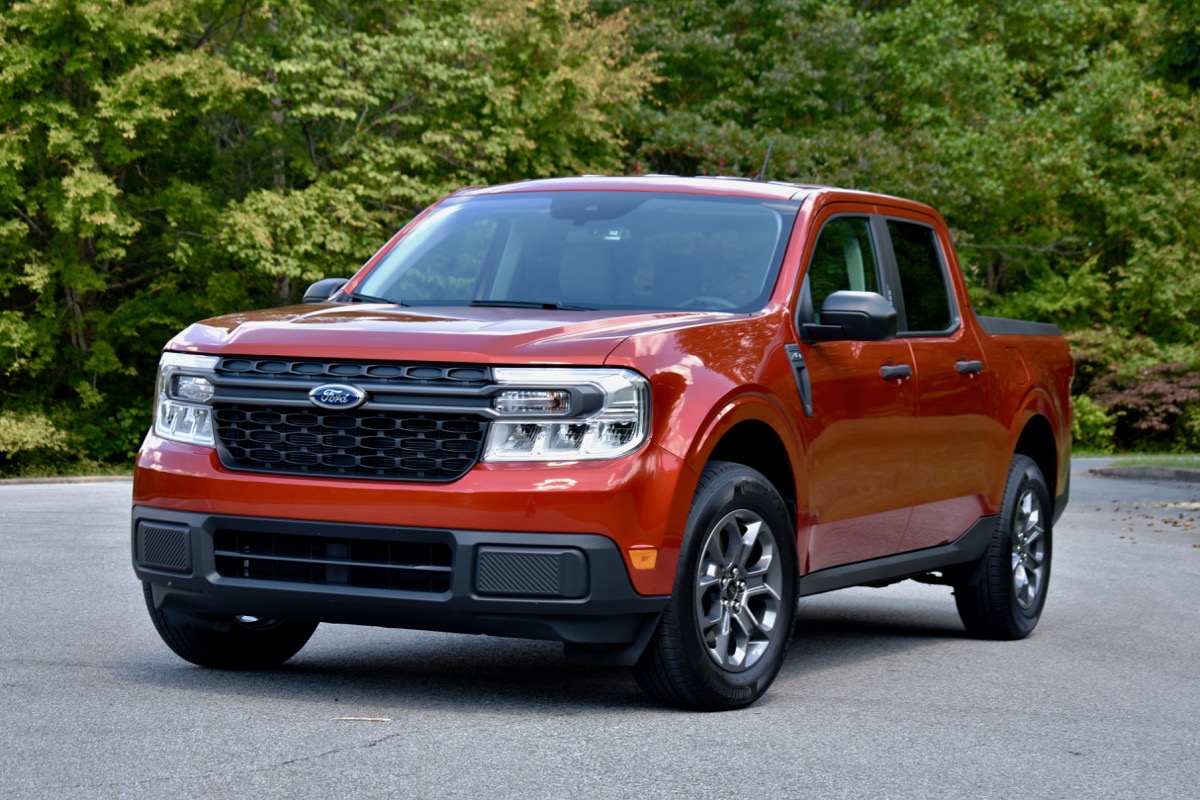
According to CarGurus experts, the overall rating for the 2022 Ford Maverick is 8.2 out of 10, while the 2022 Toyota Tacoma scores 7.5 out of 10. Given these ratings, the Ford Maverick comes out on top, offering a compelling blend of modern features, versatile utility, and solid performance. For consumers seeking a well-rounded pickup with innovative touches, the 2022 Ford Maverick is the clear recommendation.
Choose the 2022 Ford Maverick if:
- You're looking for a compact, easy-to-maneuver pickup with excellent legroom and smart interior storage solutions.
- You prefer a smoother ride typical of crossovers due to the unibody construction.
- You're interested in a vehicle with solid hybrid performance and innovative features like the Ford Integrated Tether System (FITS).
Choose the 2022 Toyota Tacoma if:
- You need a truck with robust towing and payload capacities for heavier loads.
- You value off-road capability and trail-specific features available on TRD models.
- You appreciate a reliable, albeit aged, design that suits an active, adventure-oriented lifestyle.
CarGurus highlights

According to CarGurus experts, the overall rating for the 2022 Ford Maverick is 8.2 out of 10, while the 2022 Toyota Tacoma scores 7.5 out of 10. Given these ratings, the Ford Maverick comes out on top, offering a compelling blend of modern features, versatile utility, and solid performance. For consumers seeking a well-rounded pickup with innovative touches, the 2022 Ford Maverick is the clear recommendation.
Choose the 2022 Ford Maverick if:
Shop Now- You're looking for a compact, easy-to-maneuver pickup with excellent legroom and smart interior storage solutions.
- You prefer a smoother ride typical of crossovers due to the unibody construction.
- You're interested in a vehicle with solid hybrid performance and innovative features like the Ford Integrated Tether System (FITS).
Choose the 2022 Toyota Tacoma if:
Shop Now- You need a truck with robust towing and payload capacities for heavier loads.
- You value off-road capability and trail-specific features available on TRD models.
- You appreciate a reliable, albeit aged, design that suits an active, adventure-oriented lifestyle.

By: CarGurus + AI
At CarGurus, our team of experienced automotive writers remain at the heart of our content operation, conducting hands-on car tests and writing insightful guides that are backed by years of industry experience. To complement this, we are harnessing AI to make our content offering more diverse and more helpful to shoppers than ever. To achieve this, our AI systems are based exclusively on CarGurus content, ratings and data, so that what we produce is both unique to CarGurus, and uniquely helpful to car shoppers.


















